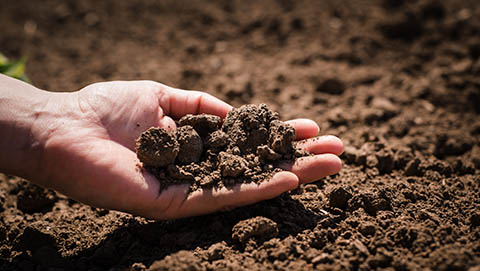Macronutrients are vital for healthy soil
Our soil’s chemical health is defined by its ability to hold and cycle macronutrients - nitrogen, phosphorus, potassium and sulphur. These react with soil to become more or less available for plant growth, so it is important to get the balance right.
![]()
For soil to have a clean bill of health, we need to be mindful of its three main elements. These elements are interrelated so if one is out of balance it can adversely affect the other two.

There are three main ways to measure the chemistry of your soil:
1. Soil testing pH levels and the availability of nutrients
Soil acidity and/or alkalinity (pH) is important as it determines the availability of soil nutrients to plants.
As well, pH is important for ensuring the optimum environment for soil dwelling organisms (e.g. earthworms and microbes) and suitability for plant growth.
If soil pH levels are too high or low, this can lead to nutrient deficiency, reduced microbial activity and decreased yields. The ideal pH range for soil health is 5.5 - 6.5.
Olsen P is key measure used to indicate the fertility level of a soil, which tells us the level of plant available nutrients present in the soil. Nutrients play important roles in plant photosynthesis, water uptake, energy storage and much, much more. Low fertility levels indicate poor availability of nutrients to plants. Excessively high Olsen P levels, however, indicate a risk of adverse environmental impact. It is therefore important to understand your soil fertility.
2. Anion storage capacity (ASC)
ASC is a measure of the ability of the soil to bind negatively charged anions such as phosphate. ASC does not change except in peat soils, where it increases over time as the soils progress from raw to developed.
3. Cation exchange capacity (CEC)
This is the soil's ability to bind positively charged cations such as potassium, magnesium, calcium and sodium. Negatively-charged binding sites are largely a function of the ratio of sand, silt and clay, plus how much soil organic matter is present. By increasing organic matter in the soil over time, we can increase the number of exchange sites and the amount of nutrients the soil can hold.
The ongoing benefits of nutrients in soil
Having healthy levels of macronutrients means plants will develop stronger and deeper roots and soil organisms will increase. This results in the land producing optimum yields, and those plants, in turn, provide more feed for soil organisms, which in turn creates more organic matter. This increased organic matter means the soil can retain more nutrients, enable better water infiltration and have a great capacity to retain water.
How can we maintain healthy nutrient levels?
Regular soil testing is by far the best way to get a reliable status on your soil's nutrient levels, along with:
- pH, CEC and ASC
- It helps you avoid over- or under-application of nutrients
- It's important to use calibrated soil tests, which have been matched against optimum pasture and crop production in New Zealand conditions.
For more information, or to begin a soil testing programme on your farm, contact your local Ballance Nutrient Specialist or our customer services team on 0800 222 090.

Healthy soil is teeming with life. One teaspoon contains 3-5 billion organisms that bring important value to the soil

Knowing the relative percentages of sand, silt, and clay in your soil helps you manage it and maintain its health

Ballance Nutrient Science Manager Dr Sheree Balvert explains the advantages of healthy soil